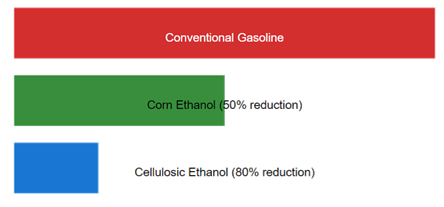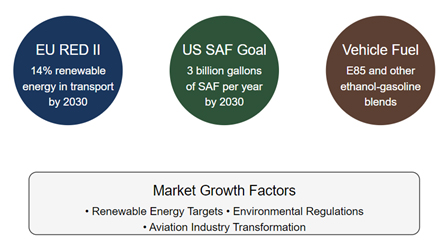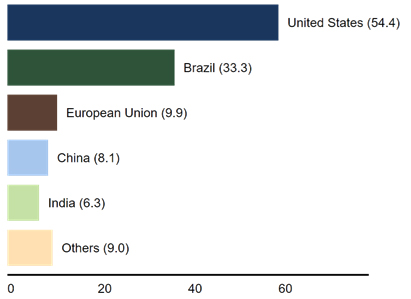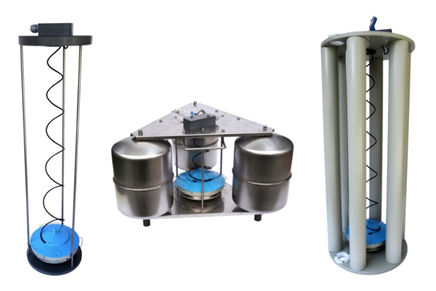Ensuring Environmental Compliance and Safety in Ethanol Storage: Advanced Detection Solutions for a Growing Market
Executive Summary
As the global demand for renewable fuels continues to rise, ethanol has emerged as a key player in the transition to more sustainable energy sources. However, with increased production and storage comes heightened environmental risks.
This white paper examines the growing ethanol market, associated environmental challenges, regulatory landscape, and innovative solutions for leak detection and prevention.
1. Global Ethanol Market: Current Trends and Future Outlook
1.1 Market Growth and Drivers
The global ethanol market is experiencing significant growth, driven by several factors:
- Renewable Energy Targets: The European Union’s Renewable Energy Directive (RED II) mandates that at least 14% of energy used in transport must come from renewable sources by 2030, with a minimum of 3.5% from advanced biofuels.
- Aviation Industry Transformation: The emergence of Sustainable Aviation Fuel (SAF) has created new opportunities for ethanol utilization, with the US setting ambitious goals through the SAF Grand Challenge to produce 3 billion gallons of SAF annually by 2030.
- Vehicle Fuel Applications: E85 and other ethanol-gasoline blends continue to play a crucial role in reducing greenhouse gas emissions from the transportation sector.
- Environmental Benefits: The significant reduction in greenhouse gas emissions achieved through ethanol use, is a major driver of market growth. As shown in Figure 1, ethanol demonstrates substantial environmental advantages compared to conventional gasoline. This data from the U.S. Department of Energy clearly illustrates why policymakers and industry leaders are increasingly turning to ethanol as a sustainable fuel alternative.

Figure 1: Ethanol’s Impact on Greenhouse Gas Emissions, Compared to Gasoline
Source: U.S. Department of Energy, Alternative Fuels Data Center
The key drivers of ethanol market growth can be categorized into three main areas:
- Policy Drivers: Including renewable energy targets and emissions regulations
- Industry Drivers: Such as aviation industry transformation and vehicle fuel applications
- Market Drivers: Encompassing increased demand for sustainable fuels and economic incentives
As illustrated in Figure 2, these interconnected factors contribute to the expanding ethanol market.

Figure 2: Ethanol Market Growth Drivers
1.1 Key Markets and Future Growth Regions
United States
- Leading global producer and consumer of ethanol
- Robust Renewable Fuel Standard (RFS) program driving continued growth
- Significant investments in infrastructure and production capacity
European Union
- Strong policy support through RED II and the Alternative Fuels Infrastructure Regulation (AFIR)
- Growing focus on advanced biofuels and sustainable aviation applications
- Expanding network of ethanol production and storage facilities
1.2 Future Demand Projections
The demand for ethanol is expected to grow substantially over the next decade, driven by:
- Increasing adoption of renewable fuels in transportation
- Expansion of the SAF market
- Stricter environmental regulations promoting alternative fuels
The current global distribution of ethanol production provides insight into future growth potential. As illustrated in Figure 3, production is currently concentrated in specific regions, with the United States leading global output. This regional distribution highlights both established markets and areas with significant growth potential as global demand increases.

Figure 3: Global Ethanol Production by Region (Billion Liters, 2022)
Source: Renewable Fuels Association (RFA), 2023 Ethanol Industry Outlook
1. Environmental Risks of Ethanol Spills
1.1 Impact on Water Bodies
Ethanol spills pose significant risks to aquatic ecosystems:
- Rapid dissolution in water, potentially affecting water quality
- Oxygen depletion in water bodies, threatening aquatic life
- Potential contamination of drinking water sources
- Increased pollution by hydrocarbons dissolved by the ethanol on its way to the water body
1.2 Soil Contamination
Ethanol spills can have lasting effects on soil environments:
- Altered soil chemistry and microbial flora and fauna
- Potential groundwater contamination through soil penetration
- Impact on vegetation
1.3 Air Quality Concerns
Ethanol spills can also affect air quality:
- Volatile organic compound (VOC) emissions
- Potential fire hazards due to ethanol’s flammable nature
- Health risks for nearby communities
2. Regulatory Framework for Ethanol Spill Prevention
2.1 United States Regulations
2.1.1 Environmental Protection Agency (EPA) Requirements
- Spill Prevention, Control, and Countermeasure (SPCC) Rule: Mandates facilities to prepare and implement comprehensive spill prevention plans
- Clean Water Act (CWA): Requires immediate reporting and action for ethanol spills
2.1.2 State-Level Regulations
Many states have additional requirements for:
- Storage tank design and maintenance
- Spill containment systems
- Regular inspections and monitoring
2.2 European Union Regulations
2.2.1 Seveso III Directive (Directive 2012/18/EU)
- Focuses on preventing major accidents involving dangerous substances
- Requires implementation of safety management systems
- Mandates emergency planning for ethanol storage facilities
2.2.2 Water Framework Directive (WFD, Directive 2000/60/EC)
- Establishes comprehensive water protection measures
- Requires prevention and control of pollution from hazardous substances
3. Leakwise ID-223ET: Advanced Ethanol Leak Detection Solution
3.1 Revolutionary Technology
The Leakwise ID-223ET sensor represents a breakthrough in ethanol leak detection:
- World first continuous field instrument for ethanol in water technology
- Utilizes High-Frequency Electromagnetic Absorption technique
- Capable of detecting ethanol concentrations from 10% to 100% by volume
- Provides real-time monitoring and early warning capabilities
The Leakwise ID-223 ET sensor system, shown in Figure 4, represents the cutting edge of ethanol leak detection technology. These robust, industrial-grade sensors are designed for reliable operation in demanding environments, combining sophisticated detection capabilities with durable construction suitable for various industrial applications.

Figure 4: Leakwise ID-223 ET sensors
1.1 Key Features and Capabilities
1.1.1 Technical Specifications
- Multiple sub-models for different water fluctuation capabilities:
- ID-223ET/500: up to 500 mm variation in water level
- ID-223ET/2000: up to 5,000 mm variation in water level
- ID-223ET/2500: up to 5,500 mm variation in water level
- Operating temperature range: 0-70°C (32-158°F)
- Certified for hazardous locations (ATEX, IECEx, UKEX, cETLus)
1.1.2 Monitoring Capabilities
- Continuous real-time detection
- Two field-adjustable alarm points
- 4-20 mA analogue output for concentration monitoring
1.2 Applications and Benefits
1.2.1 Versatile Implementation
- Storage tank monitoring
- Ethanol blending facilities monitoring
- Wastewater treatment plants
- Stormwater run-off areas
- Sewer systems at ethanol manufacturing facilities
1.2.2 Regulatory Compliance
- Helps facilities meet EPA SPCC requirements
- Supports compliance with EU directives
- Provides documentation for regulatory reporting
1.2.3 Detection of other miscible liquids in water, such as Methanol
- While utilizing the High-frequency Electromagnetic Absorption technology, the ID-223 ET sensor can detect other miscible liquids in water, while setting the sensor’s sensitivity accordingly
- Methanol in water was successfully detected by the sensor in the same concentration ranges as ethanol
2. Conclusion
As the global ethanol market continues to expand, the importance of effective leak detection and prevention cannot be overstated. The Leakwise ID-223ET sensor represents a critical advancement in protecting the environment from ethanol spills while ensuring regulatory compliance. By implementing such cutting-edge solutions, facilities can minimize risks, protect the environment, and contribute to the sustainable growth of the ethanol industry.
For more information about Leakwise oil leak detection systems and to request a customized solution for your facility, please contact Leakwise www.leakwise.com info@leakwise.com
